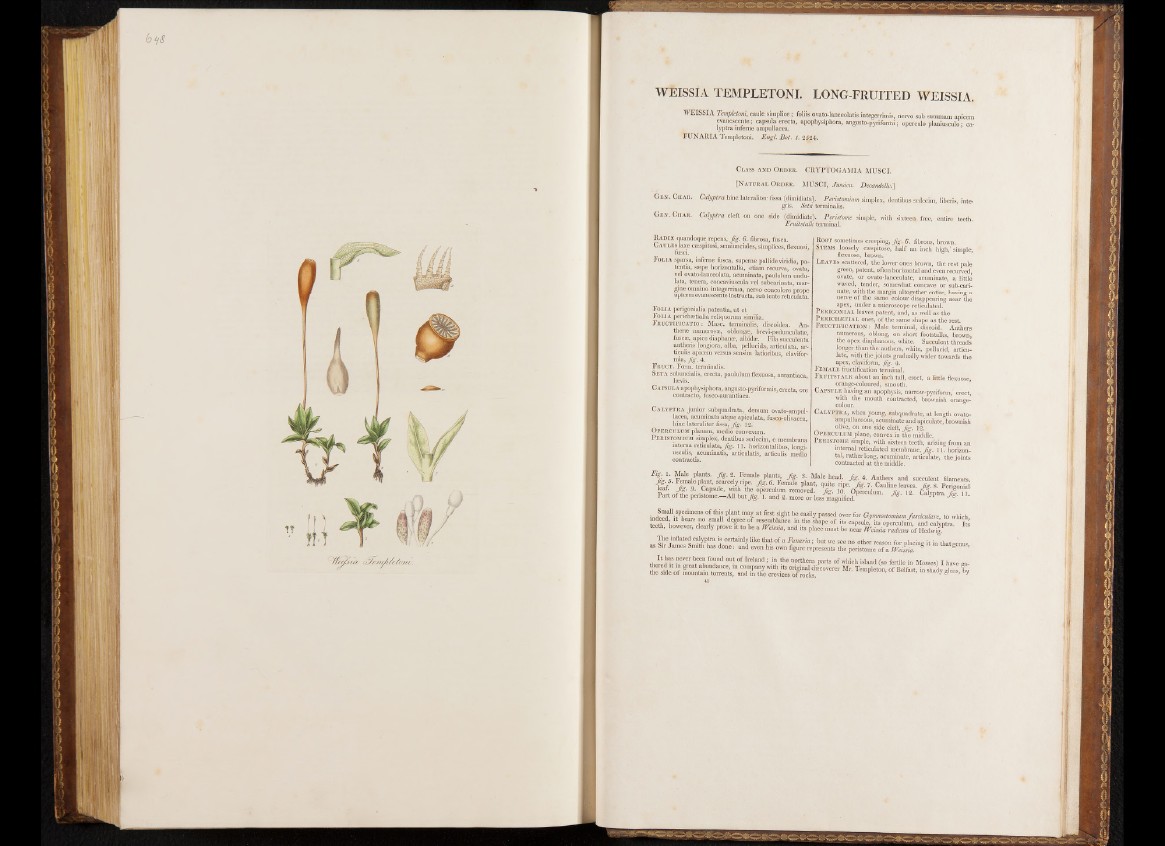
WÊISSÏA TEMPLETONI. LONG-FRUITED WEISSIA,
WEISSIA Templetoni, caule Bunplice; foliis ovato-lanceolatis integerrimis, nervo sub summam apicem
evanescent® ; capsula erecta, apophysiphora, angusto-pyriformi ; operculo planiusculo ; oa-
lyptra mferne ampullacea.
FUNARIA Templetoni. Engl. Bot. t. 2524.
Class an d Order. CRYPTOGAMIA MUSCI.
[Natural Order. MUSCI, Jussieu. Becaniolle.]
Ge S. Chak. Calyptra hinc lateralilcr iissa (dimidiate). Peristomium simplex, dentibus sctlecim, liberis, inte-
gris. Seta terminalis.
G e s . Char. Calyptra cleft on one side (dimidiate). Peristome simple, with sixteen, free, entire teeth.
Fruit stalk terminal.
Radix quandoque repens, fig. 6. fibrosa, fusca.
Caules laxe casspitosi, semiunciales, simplices, flexuosi,
fusci.
Folia sparsa, inferne fusca, superne pallide viridia, pa-
tentia, sæpe ho ri zon tal ia, etiam recurva, ovata,
vel ovato-lanceolata, acuminata, paululum undu-
lata, tenera, concaviuscula vel subcarinata, mar-
gine omnino integerrima, nervo concolore prope
apicem evanescente instructa, sub lente reticulata. ;
F olia perigönialia patentia, ut et
Folia perichætialia reliquorum si milia.
Fructificatio : Masc. terminalis, discoidea. An-
thene numerosæ, oblongæ, brevi-pedunculatæ,
fuscæ, apice diaphanæ, albidæ. Fila succulenta
antheris longiora, alba, pellucida, articulata, ar- ,
ticulis apicem versus sensim latioribus, clavifor-
mia, fig. 4.
Fruct. Foem. terminalis.
Seta subuncialis, erecta, paululum flexuosa, aurantiaca,
lasvis.
Capsula apophysiphora, angusto-pyriformis, erecta, ore
contracta, fusco-aurantiaca.
Calyptra junior subquadrata, demum ovato-ampul-
lacea, acuminata atque apiculata, fusco-clivacea,
hinc lateraliter fissa, Jig. 1 2 .
Operculum planum, medio convexum.
Peristomium simplex, dentibus sedecim, e membrana
interna reticulata, fig. i l . horizontalibus, longi-
usculis, acuminatis, articulatis, articulis medio
contractis.
Root sometimes creeping, fig. 6. fibrous, brown.
Stems loosely ctespitose, half an inch high,' simple,
fiexuose, brown.
L eaves scattered, the lower ones brown, the rest pale
green, patent, often horizontal and even recurved,
ovate, or ovato-lanceolate, acuminate, a little
waved, tender, somewhat concave or sub-carinate,
with the margin altogether entire, having a
nerve of the same colour disappearing near the
apex, under a microscope reticulated.
Perig o n ia l leaves patent, and, as well as the
Perichjetial ones, of the same shape as the rest.
Fructification : Male terminal, discoid. Anthers
numerous, oblong, on short footstalks, brown,
the apex diaphanous, white. Succulent threads
longer than the anthers, white, pellucid, articulate,
with the joints gradually wider towards the
apex, claviform, fig. 4 .
IE male fructification terminal.
Fruitstalk about an inch tall, erect, a little fiexuose,
orange-coloured, smooth.
Capsule having an apophysis, narrow-pyriform, erect,
with the mouth contracted, brownish orange^
colour.
Calyptra, when young, subquadrate, at length ovato-
ampullacepus, acuminate and apiculate, brownish
olive, on one side cleft, Jig. 12.
Operculum plane, convex in the middle.
Peristome simple,, with sixteen teeth, arising from an
internal reticulated membrane, Jig. 1 1 . horizontal,
rather long, acuminate, articulate, the joints
contracted at the middle.
Eg. 1. Male plants Jig. a Female plants, &■. 3. Male head. Jig. 4. Anthers and succulent filaments
f e .5 . Female ptant, scarcely ripe. Jig. 6. Female plant, quite ripe. Jig. 7 . Cauline leaves. Jig. s. Perigonial
d 1 c l ' 9‘ .CaPsule> the operculum removed, fig. 10. Operculum, fis 12 CdvDtra for 1 1
Part of the penstome.—All but Jig. l . and 2. more or less magnified. yP 1
i n d e S f f tT i r " „ S„0 f “ n PJ “ * ma? at firs;,siSht ¥ easily passed over for Gymwstomium fasciculate, to which
indeed ft bears no small degree o f resemblance m the shape of its capsnlef its operculum, and cal ipf raI t e
teeth, however, clearly prove it to be a Weissia, and its place must he Jar Weissia\ a d ia Z o f Hed^rif
The inflated calyptra is certainly like that o f a Punaria; but we see no other reason for placing it in that genus
as Sir James Smith has done: and even his own figure represents the peristome of a Weissia. ° “ ’
thered ft B H I 1 °“t °f Irel“d; I ?'e B °f »'hlch island (so fertile in Mosses) I have ga-
S h E B I P S T T WIth -lts S S l S dlsceverer Mr. Templeton,the side of mountain torrents, and in the crevices of rocks. of Belfast, in shad*y ®g lensJ by